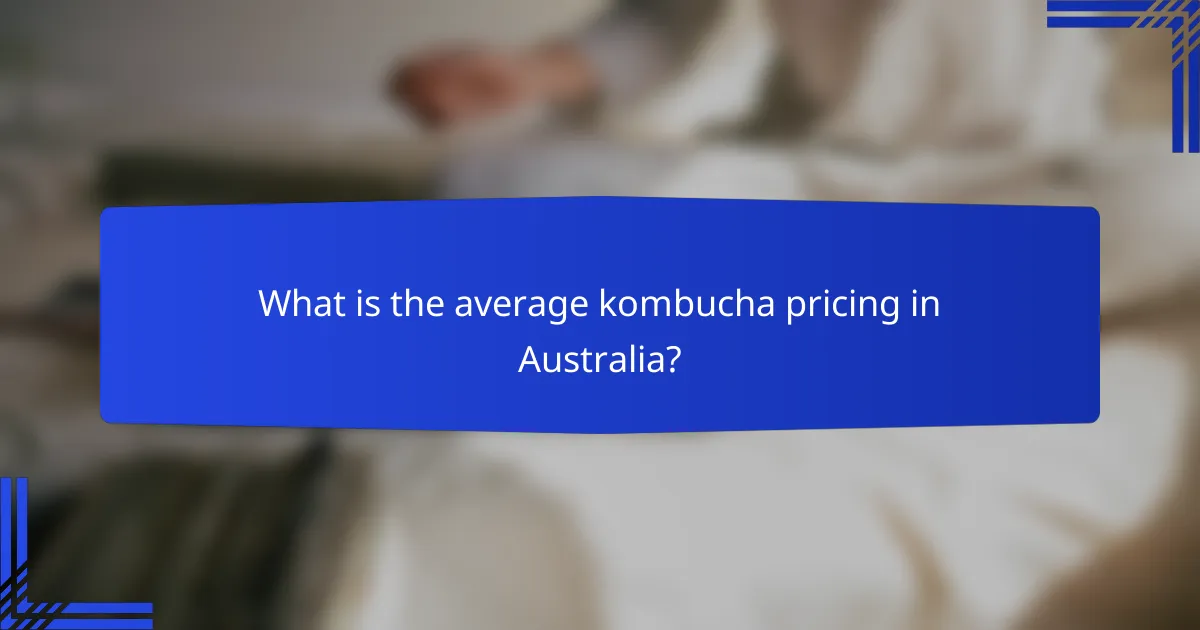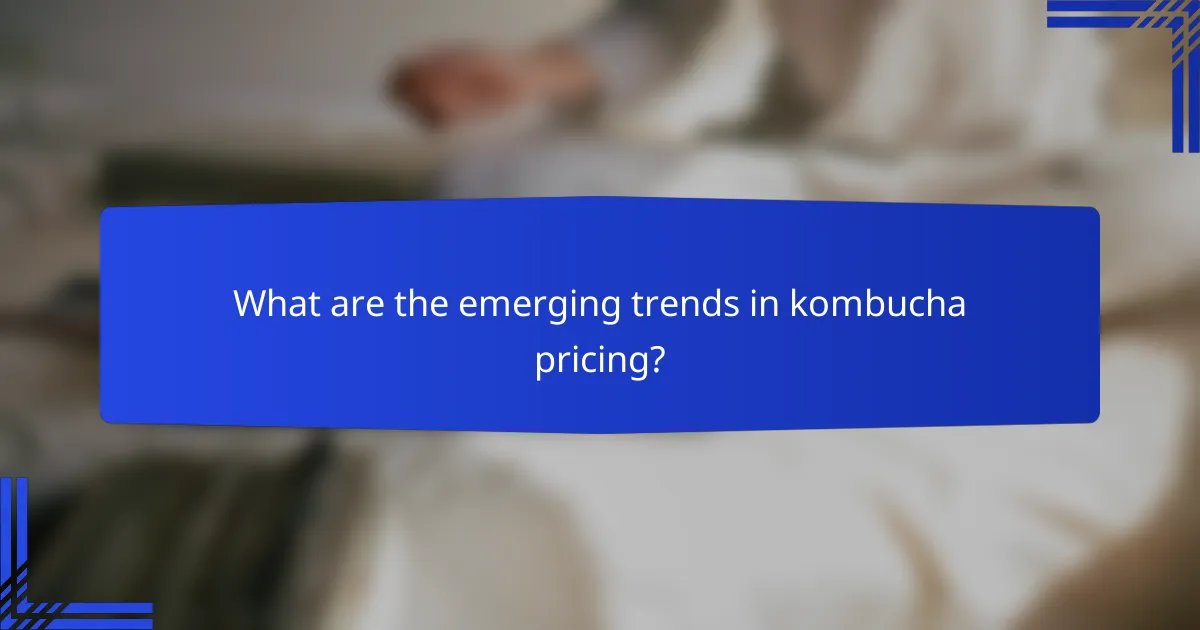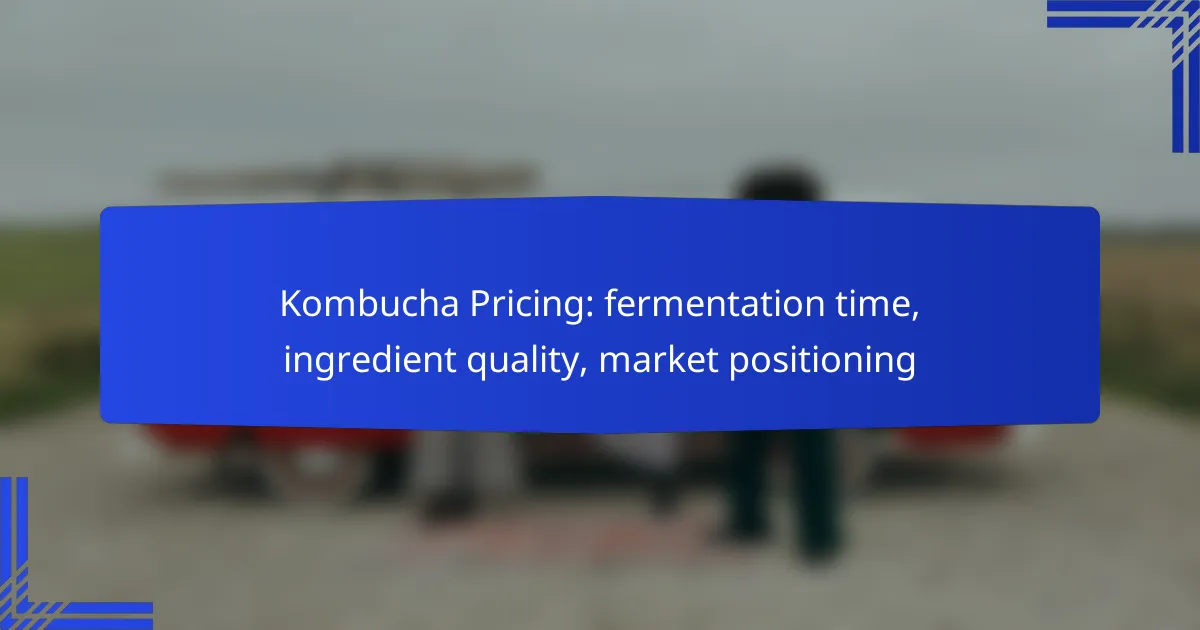Kombucha pricing in Australia generally falls between AUD 3 and AUD 7 per bottle, influenced by factors such as brand reputation, ingredient quality, and fermentation time. Longer fermentation periods often enhance flavor complexity and quality, justifying higher prices, while premium ingredients contribute to both production costs and the overall health benefits of the beverage.

What is the average kombucha pricing in Australia?
The average kombucha pricing in Australia typically ranges from AUD 3 to AUD 7 per bottle, depending on various factors such as brand, ingredients, and fermentation time. Consumers can expect to pay more for premium or organic options, which often feature higher-quality ingredients.
Retail price range for kombucha
In retail settings, kombucha prices generally fall between AUD 3 and AUD 7 for a standard 330ml bottle. Larger bottles, such as 750ml, can range from AUD 6 to AUD 12. Specialty brands or those with unique flavors may command higher prices, sometimes exceeding AUD 10 per bottle.
Factors affecting kombucha pricing
Several factors influence kombucha pricing, including fermentation time, ingredient quality, and production methods. Longer fermentation times may enhance flavor but can also increase costs due to longer storage and labor requirements.
Ingredient quality plays a significant role; organic or locally sourced ingredients typically lead to higher prices. Additionally, brands that emphasize sustainability or artisanal production methods may position themselves at a premium price point.
Comparison with other beverages
Kombucha pricing is generally higher than that of traditional soft drinks, which often retail for around AUD 2 to AUD 4 per bottle. However, it is comparable to other health-focused beverages like cold-pressed juices, which can range from AUD 5 to AUD 10.
When comparing kombucha to alcoholic beverages, such as craft beer, prices can vary widely. Craft beers typically range from AUD 6 to AUD 12 per bottle, making kombucha a more affordable option for those seeking a non-alcoholic alternative.

How does fermentation time impact kombucha pricing?
Fermentation time significantly influences kombucha pricing due to its effects on flavor, quality, and production costs. Longer fermentation typically results in a more complex flavor profile and higher quality, which can justify a higher price point in the market.
Short fermentation vs. long fermentation
Short fermentation, usually lasting a week or less, produces a milder, sweeter kombucha with lower acidity. This type is often favored by those new to kombucha or who prefer a less tangy taste.
In contrast, long fermentation can extend from two to four weeks, resulting in a more robust flavor and higher acidity. This process allows for greater development of beneficial probiotics, appealing to health-conscious consumers.
Cost implications of fermentation time
Shorter fermentation times generally require less labor and lower overhead costs, making them more affordable to produce. As a result, these kombuchas are often priced lower, appealing to budget-conscious buyers.
Longer fermentation, while potentially more costly due to increased labor and storage needs, can command higher prices due to the perceived quality and health benefits. Producers may charge a premium for these products, reflecting the time and care invested in their creation.

What role does ingredient quality play in kombucha pricing?
Ingredient quality significantly influences kombucha pricing, as higher quality components often lead to better flavor and health benefits. Premium ingredients can increase production costs, which are reflected in the final price consumers pay.
Organic ingredients and pricing
Using organic ingredients typically raises the cost of kombucha production due to stricter farming practices and certification fees. However, many consumers are willing to pay a premium for organic products, often resulting in higher retail prices that can range from 20% to 50% more than non-organic options.
Brands that emphasize organic ingredients can position themselves as health-conscious and environmentally friendly, appealing to a growing market segment that prioritizes sustainability.
Impact of sourcing local ingredients
Sourcing local ingredients can enhance the flavor profile of kombucha while supporting local economies. However, local sourcing may lead to higher costs due to limited availability and seasonal variations, which can affect pricing.
Consumers often appreciate the freshness and community support associated with locally sourced ingredients, which can justify a higher price point. Brands should communicate the benefits of local sourcing to attract customers who value quality and locality in their purchases.

How does market positioning affect kombucha pricing?
Market positioning significantly influences kombucha pricing by determining how brands are perceived in terms of quality and value. Premium brands often charge more due to higher ingredient quality and unique flavors, while budget brands focus on affordability, impacting their market share and consumer base.
Premium vs. budget kombucha brands
Premium kombucha brands typically emphasize high-quality ingredients, longer fermentation times, and unique flavor profiles, leading to higher prices, often ranging from $3 to $6 per bottle. In contrast, budget brands may use lower-cost ingredients and faster production methods, pricing their products between $1 and $3.
Consumers often associate premium brands with health benefits and artisanal craftsmanship, which can justify the higher price point. Budget brands, while more accessible, may sacrifice some flavor complexity and health attributes, appealing to price-sensitive customers.
Brand reputation and pricing strategies
Brand reputation plays a crucial role in kombucha pricing strategies. Established brands with a loyal customer base can command higher prices due to perceived trust and quality, often employing premium pricing strategies to reinforce their market position.
Newer brands may adopt penetration pricing to attract customers quickly, offering lower prices initially to build recognition. As they grow, they might gradually increase prices while enhancing their brand image, balancing quality perceptions with consumer expectations.

What are the key factors to consider when pricing kombucha?
Key factors in pricing kombucha include the cost of production, ingredient quality, and understanding your target audience. These elements directly influence the final retail price and market positioning of your product.
Cost of production
The cost of production encompasses all expenses related to brewing kombucha, including raw materials, labor, and overhead. Quality ingredients, such as organic tea and sugar, can significantly increase costs, while efficient brewing processes can help keep expenses manageable.
On average, production costs for a batch of kombucha can range from a few dollars to several tens of dollars, depending on the scale and ingredient choices. It’s essential to calculate these costs accurately to ensure profitability while remaining competitive in the market.
Target audience analysis
Understanding your target audience is crucial for effective pricing strategies. Factors such as demographics, preferences, and purchasing power will dictate how much consumers are willing to pay for kombucha. For example, health-conscious consumers may prioritize high-quality ingredients and be willing to pay a premium.
Conducting market research can help identify your audience’s preferences and price sensitivity. Consider offering different product lines, such as budget-friendly options alongside premium varieties, to cater to a broader range of customers while maximizing sales potential.

What are the emerging trends in kombucha pricing?
Emerging trends in kombucha pricing reflect shifts in consumer preferences, ingredient quality, and market positioning. As health consciousness rises, prices are adjusting to accommodate premium ingredients and longer fermentation times, impacting overall market dynamics.
Impact of health trends on pricing
Health trends significantly influence kombucha pricing, as consumers increasingly seek beverages that offer functional benefits. Products made with organic, high-quality ingredients often command higher prices, reflecting the cost of sourcing and production.
Additionally, the popularity of specific health claims, such as probiotics and detoxification, can lead to premium pricing. Brands that effectively market these benefits may see their prices rise, as consumers are willing to pay more for perceived health advantages.
Future pricing predictions in the Australian market
In the Australian market, kombucha pricing is expected to trend upward due to increasing demand for premium products. As more consumers prioritize health and wellness, brands may raise prices to reflect the higher costs of quality ingredients and sustainable practices.
Moreover, competition among local and international brands could stabilize prices in the short term, but long-term projections suggest a gradual increase as the market matures. Consumers should anticipate prices ranging from AUD 3 to AUD 6 per bottle, depending on brand positioning and ingredient quality.
